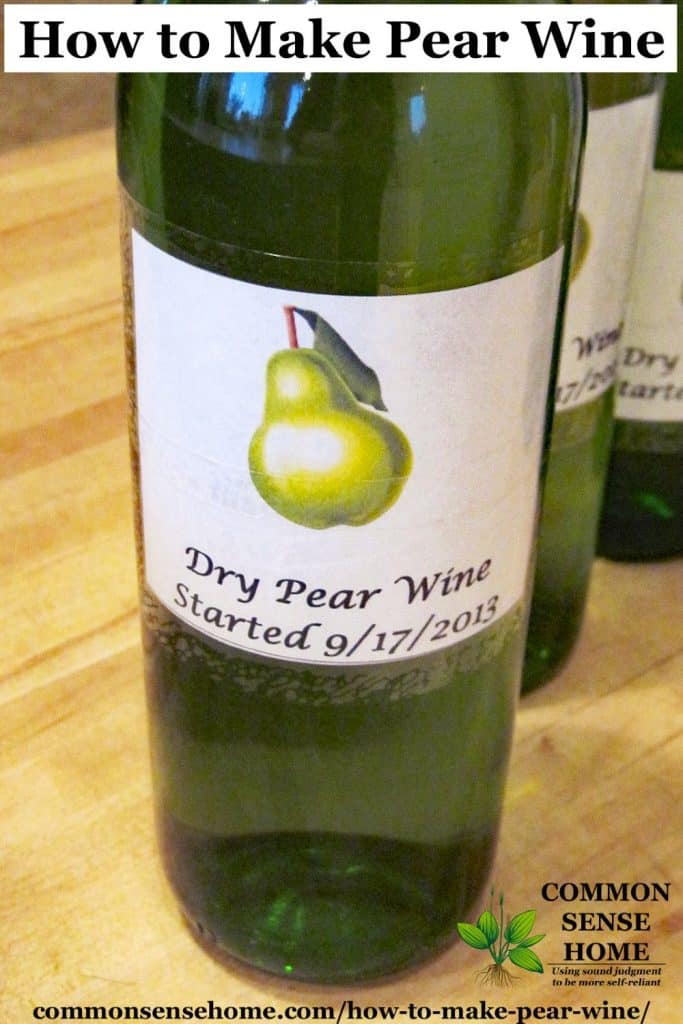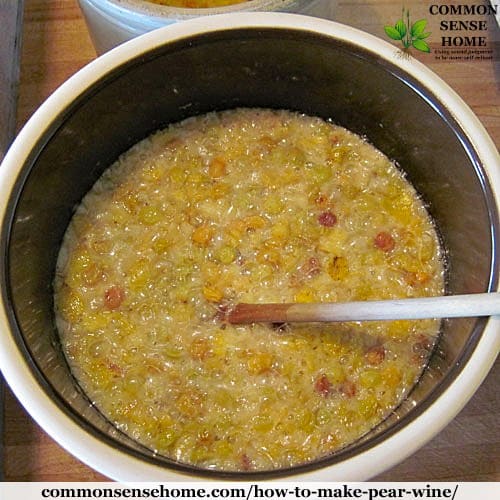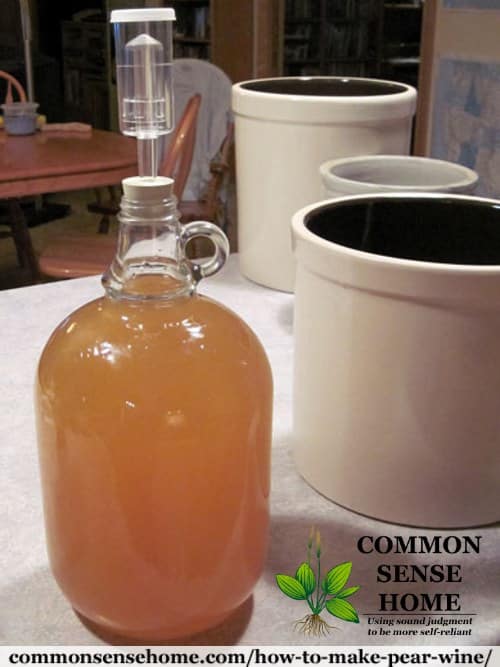How Do You Know When a White Peach Is Ripe?
This post may incorporate affiliate links which won't change your price only will share some commission.

When life gives you too many overripe pears, it'south fourth dimension to acquire how to brand pear vino. This wine recipe is dry out, with a calorie-free pear flavor, and is a good use for very ripe and lightly damaged pears.

This recipe is adapted from "How to Make Wine in Your Own Kitchen" by Mettja C. Roate. "How to Make Wine in Your Own Kitchen" is old and hard to notice, just if you tin can find a copy, snatch it up.
The recipes use common kitchen ingredients instead of specialized vino making ingredients, which is keen for the novice or incidental brewer. I did tweak the recipe a petty to include vino making yeast.
You lot can make homemade wine with wild yeasts, only information technology'south easy to make a mistake and go from bootleg wine to bootleg vinegar.
If you bask making country wines with wide diversity of ingredients, "Wild Wine Making" by Richard W. Bender is now available from Storey Publishing. It features pear vino, blueberry-pear vino and pear-black currant vino, along with 142 other fun recipes.
At that place are fruit & vegetable wines; flower & herb wines; hot pepper wines and cannabis wines. The photos are gorgeous and the author takes the mystery out of successful wine making.
You may as well discover that yours truly is also mentioned on the back cover, as I was offered a preview of the book before it released.
Contents
- Bootleg Pear Wine Recipe
- Ingredients
- Directions
- Fermenting the Pear Vino
- Bottling the Pear Wine
- Links to Buy Wine Making Equipment Online
- Give Your Homemade Pear Wine Some Extra Kick
- More Homemade Wine Recipes
- Print Friendly Recipe
- Homemade Pear wine
- Ingredients
- Instructions
- Fermenting the Pear Vino
- Bottling the Pear Vino
- Notes
- Did you make this recipe?
Homemade Pear Vino Recipe
Ingredients
Adapted from "How to Make Wine in Your Own Kitchen". Makes effectually 1 gallon of homemade wine.
- four quarts of chopped, unpeeled ripe pears (approximately five pounds)
- three cups of white raisins, chopped
- vi cups of cane carbohydrate
- i cup of light brownish sugar
- 4 quarts of water
- i packet champagne yeast Club champagne yeast
- one teaspoon yeast nutrient (optional) Order yeast nutrient
Directions
Annotation: If y'all do not have a crock, you may ferment your wine in any big, food rubber container – just don't use aluminum or annihilation reactive. Some local hardware stores or home brewing store carry crocks in addition to other fermenting vessels. I use a 2 gallon crock because the wine foams up during initial fermentation.
Pears should be ripe plenty that stems pull out easily. If non, ready aside and look a few more days. (Pears ripen off the tree.) Wash, trim, quarter and finely chop or trounce the pears. Skins are fine to include, simply proceed the seeds out. Pear seeds are bitter and can give the wine an off flavor. Trounce pears with a irish potato masher or well washed hands. Place pears and raisins into crock.
In a medium stockpot, dissolve brown and white sugar in two quarts water over low heat. Bring to a eddy, and and so set up aside to cool to lukewarm.
Add 2 quarts water to fruit mash in crock, and so add the sugar water. Stir well to evenly distribute the carbohydrate throughout the mix. Sprinkle yeast and yeast nutrient over top of mash, stir in to mix until completely dissolved and well blended.

Fermenting the Pear Wine
Comprehend and proceed in a warm location for 3 weeks, stirring daily and mashing fruit confronting the side of the crock. I employ a flour sack towel secured with an old elastic caput band to embrace my wines. Fruit flies love fermented foods, so make certain your container is well sealed.
At the finish of the initial three week fermentation period, strain mixture through a jelly purse or flour sack towel, squeezing very dry. Render liquid to crock. Set in a warm place to ferment for two weeks longer. No stirring is necessary during this second fermentation.
At the end of the second ferment (which makes five weeks in all), strain liquid through several thicknesses of cheesecloth or a flour sack towel. Siphon or ladle into the strainer, leaving the sediment at the lesser of the crock. (You're aiming for a articulate production at this indicate.)
Render the articulate wine to the crock or a carboy for two days to permit it to settle again. Put the cloudy vino from the bottom of the crock into a two quart jar to settle for two days so draw off as much clear liquid as possible. Add to the residuum of the vino and let to sit for some other day.

Bottling the Pear Wine
Once the pear wine has settled, y'all tin can either bottle it directly into bottles or place in a carboy. In that location may be a little active yeast at this bespeak, and then if you put information technology in bottles, put balloons over the openings so the gasses tin can escape. When the balloons don't inflate anymore, cork the bottles and historic period in a cool dark location for at least half-dozen to 12 months before drinking.
If using a carboy, siphon wine into carboy, keeping your siphon hose off the lesser of the crock to get out the wine dregs behind. Place airlock and historic period in carboy for 6 months before bottling. When bottling, siphon into bottles, leaving dregs in the bottom of the carboy for a clearer wine. We demonstrate in the video beneath.
Using a carboy gives a clearer wine, since you leave backside the sediment one extra fourth dimension.
Links to Buy Wine Making Equipment Online
- 2 gallon crock
- One gallon drinking glass carboy with airlock
- Wine bottles
- Wine canteen corks
- Double Lever Vino Bottle Corker
"How to Make Wine in Your Own Kitchen" notes…
If yous desire more character in your wine, add 1/four pound of candied ginger, finely chopped, at the aforementioned fourth dimension as the raisins. If you desire oestrus along with the spicy taste, besides add ten or twelve blackness peppercorns.
At that place was an attempt to market pear wine commercially in this country at one fourth dimension. Even so, due to its blandness, winemakers found information technology had to exist fortified upward to 20% with pear brandy. Homemade wine can be fortified, too, for meliorate results. I observe that using a skilful grade of grape brandy gives a wonderful flavor. I add together this just before the ii-mean solar day settling menstruum, using about two cups of brandy to a gallon.
In France and Germany there is a pear champagne which is made in much the same manner; however, it is bottled and corked tightly, while in the fermenting stage, giving information technology effervescence when opened.
More than Bootleg Vino Recipes
Winemaking makes the kitchen smells a bit like hooch at times, simply information technology'south pretty tasty hooch. Homemade wine is great way to use up an abundance of produce that might otherwise go to waste material. It'south condom to give the leftover pear wine brew to the chickens, too, or use it to make fruitcake. Just make certain non to requite them so much that they get drunk. 🙂
Other bootleg wine recipes on the site include:
- Like shooting fish in a barrel Strawberry Wine Recipe – Perfect for Beginners
- Pumpkin Wine
- Dandelion Wine
- Elderberry wine
- Quackgrass Wine
Demand more pear ideas? Check out 9 Ways to Preserve Pears, Plus Tips to Prevent Browning.

Print Friendly Recipe
Homemade Pear wine
This easy homemade pear wine recipe combines just a few simple ingredients to turn an abundance of ripe pears into delicious homemade vino.
- Yield: 1 gallon one10
- four quarts of chopped, unpeeled ripe pears (approximately v pounds)
- 3 cups of white raisins, chopped
- six cups of cane sugar
- 1 cup of low-cal brown saccharide
- 4 quarts of water
- 1 packet champagne yeast
- 1 teaspoon yeast nutrient (optional)
Pears should be ripe plenty that stems pull out hands. If not, set aside and wait a few more days. (Pears ripen off the tree.) Wash, trim, quarter and finely chop or crush the pears. Skins are fine to include, only keep the seeds out. Pear seeds are bitter and can give the wine an off flavor. Crush pears with a tater masher or well washed hands. Place pears and raisins into crock.
In a medium stockpot, dissolve brown and white sugar in two quarts water over low rut. Bring to a eddy, and then set aside to absurd to lukewarm.
Add ii quarts water to fruit mash in crock, so add together the sugar water. Stir well to evenly distribute the sugar throughout the mix. Sprinkle yeast and yeast nutrient over top of mash, stir in to mix until completely dissolved and well blended.
Fermenting the Pear Wine
Cover and keep in a warm location for 3 weeks, stirring daily and mashing fruit against the side of the crock. I use a flour sack towel secured with an sometime elastic head band to cover my wines. Fruit flies love fermented foods, so make sure your container is well sealed.
At the end of the initial iii week fermentation period, strain mixture through a jelly bag or flour sack towel, squeezing very dry out. Return liquid to crock. Ready in a warm place to ferment for 2 weeks longer. No stirring is necessary during this second fermentation.
At the cease of the 2nd ferment (which makes five weeks in all), strain liquid through several thicknesses of cheesecloth or a flour sack towel. Siphon or ladle into the strainer, leaving the sediment at the bottom of the crock. (You're aiming for a clear product at this indicate.)
Render the articulate wine to the crock or a carboy for 2 days to let it to settle again. Put the cloudy vino from the bottom of the crock into a two quart jar to settle for ii days then draw off as much articulate liquid equally possible. Add to the residuum of the wine and allow to sit for another mean solar day.
Bottling the Pear Wine
Once the pear wine has settled, you can either bottle it direct into bottles or place in a carboy. There may exist a piddling active yeast at this point, so if you put it in bottles, put balloons over the openings so the gasses tin can escape. When the balloons don't inflate anymore, cork the bottles and age in a cool dark location for at to the lowest degree 6 to 12 months before drinking.
If using a carboy, siphon vino into carboy, keeping your siphon hose off the bottom of the crock to exit the wine dregs behind. Place airlock and age in carboy for 6 months before bottling. When bottling, siphon into bottles, leaving dregs in the bottom of the carboy for a clearer wine.
Using a carboy gives a clearer wine, since you leave backside the sediment one extra time.
Notes
Note: If yous practise non have a crock, you may ferment your vino in whatsoever big, food safety container – just don't utilize aluminum or anything reactive. Some local hardware stores or domicile brewing store carry crocks in addition to other fermenting vessels. I use a two gallon crock because the wine foams up during initial fermentation.
Originally published in 2011, last updated in 2018.

How Do You Know When a White Peach Is Ripe?
Source: https://commonsensehome.com/how-to-make-pear-wine/

0 Response to "How Do You Know When a White Peach Is Ripe?"
Post a Comment